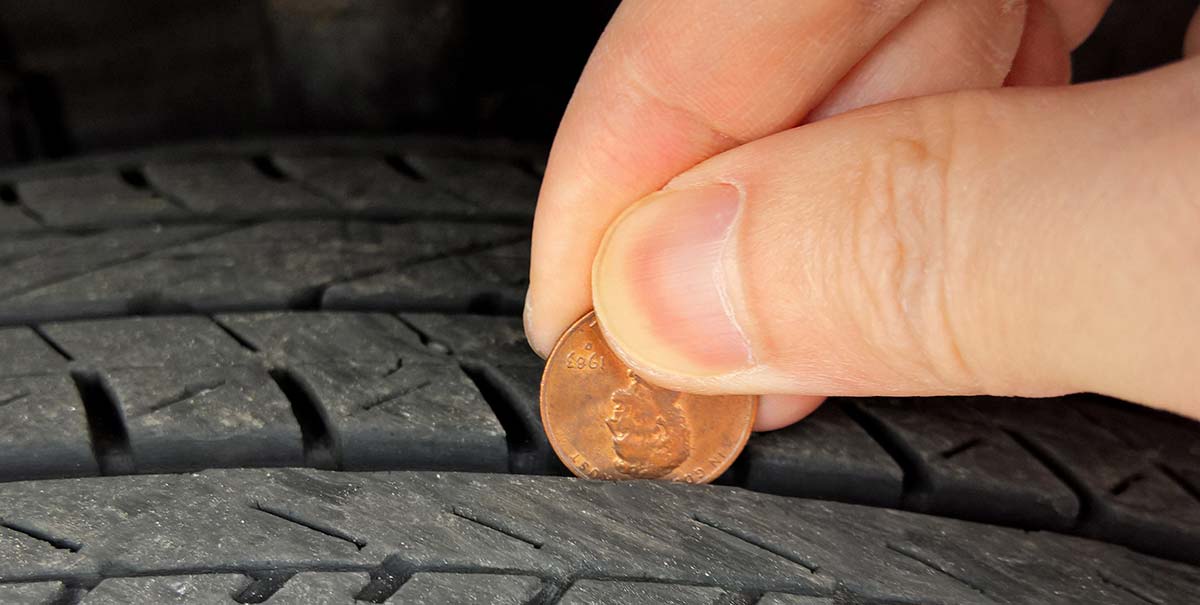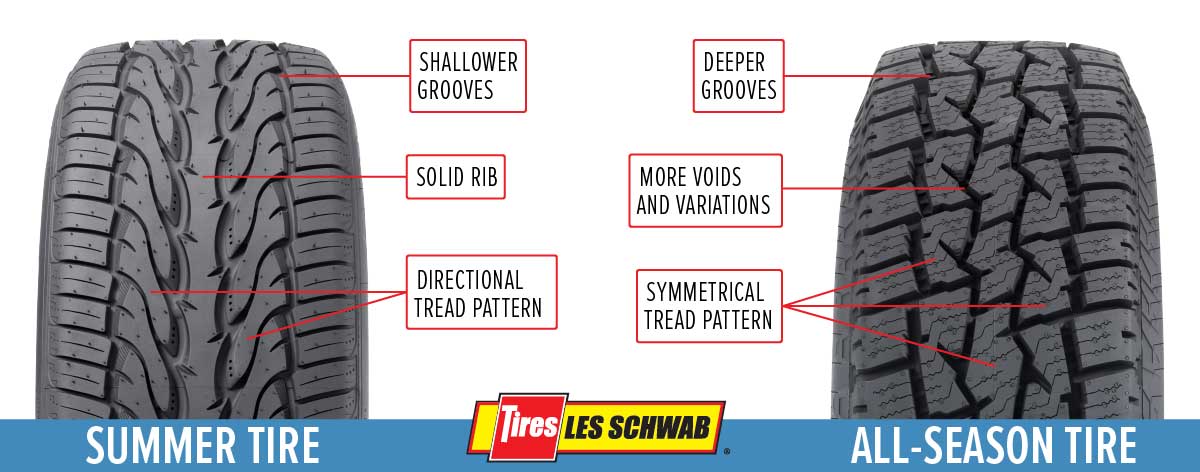-
Why Worn Tires Are Less Safe
When it comes to safety on the road, your tires are one of the most important parts of your vehicle. And the tire tread on those tires is where the rubber literally meets the road! However, as you drive, more of that tire tread disappears. Over time, that can add up to less stopping power and maneuverability in different weather conditions. It can also mean more punctures resulting in air loss. We’ve compiled some of the reasons why worn tires are less safe and when you should replace them.
Tires Equal Performance
According to the National Highway Traffic Safety Administration, nearly half of all vehicles on the road have at least one half-worn tire. That means the depth of the tire tread is half of what it was when the tire was new.
Tire tread depth on a new car tire is usually around 10/32 to 11/32 inches. Light trucks are between 11/32 and 19/32 inches. For a car, half-worn would mean the tire tread depth was around 6/32 inches. Due to safety concerns, many states require tires be replaced when they reach 2/32 inches, which is considered bald.
Measuring Your Tread
Loosely measuring the tire tread depth on your tires is easy. All you need is a shiny penny. Check out Tire Tread and the Useful Penny Test to learn how to measure yours. Or get yourself a tread-depth gauge, which is far more precise. To help you spot bald tires, manufacturers have added horizontal rubber bars at the base of tire tread grooves. If those molded horizontal bars are flush with the surrounding tread, then your tires are more-than ready to be replaced.

At Les Schwab, we recommend you get new tires before they reach 2/32 inches. Here’s why.
Tire Tread Keeps You in Control
As tires lose tread, the sipes or channels in between the tire tread disappear. This means you have less grip on snowy and icy roads. It can take far longer to accelerate with half-worn tires, and can dramatically reduce your stopping distance.
In the rain, you have a greater chance of hydroplaning at higher speeds. Plus, half-worn tires don’t deliver the stopping power of new tires in the rain and standing water.
Tire Tread Repels Objects Better
The lower your tire tread gets, the easier it is for nails, screws, and other tire-piercing items to ruin your day with a flat tire.
Pro Tip: Check Your Tire Tread Every Other Month
Measure and look for reduced tire tread every time you add air to your tires. For most folks, that’s every other month or so. Or you can just swing by your local Les Schwab and we’ll check the air pressure and your tire tread depth for free. That includes looking for cracks, cuts, or bulges in the sidewall, and uneven wear. Schedule your appointment now or stop by before your next road trip down the highway or into the mountains.
Schedule an Appointment -
Winter Driving Tips: Traction Tires & Snow Chains
If you’ve ever faced a winter storm from the driver’s seat of your vehicle, you know it can get a little tense. Especially when it’s icy, snowy, or pouring down rain. You might not be able to avoid winter, but you can be ready for your trip over the mountain or across town.
Traction is Your Friend
A good set of tires is essential for winter driving, whatever the weather. Heading into some serious conditions, like ice and snow? A set of snow chains can help keep you on the road instead of waiting for a tow truck.
Adding snow tires to your vehicle is an option. These include studded and studless options for the snow and ice, as well as siping for added grip in heavy rain. Get the full scoop on how to choose winter tires.
Get to know snow chains. Winter weather can be unpredictable and we want you to be prepared and safe wherever you're driving. Before the harsh weather hits, get a pair of correctly fitting tire chains for your vehicle and practice installing them in a warm garage. You can check out our quick tutorial. If you purchase your tire chains from Les Schwab and they sit in your trunk all season without being used, bring them back with proof of purchase to any of our locations in the spring and we'll issue you a full refund.
Drive Smart in Any Weather
Traction tires and devices are a good idea, whether you’re taking the family up to the slopes or driving home from work. And so is smart driving. Whatever the conditions, give yourself plenty of room to stop. When the pavement is wet, put at least 120 feet between you and the next car or truck. On snow, give yourself 180 feet. And if there’s ice on the road, get really generous with 600 feet of stopping distance. You’ll be glad you did.
SHOP WINTER TIRES -
Summer Tires vs All-Season Tires: Which Are Best for You?
When you buy a new set of tires, it’s important you choose a set that meets your needs. Do you value comfort and a quiet ride, cost savings with fuel efficiency, longevity, performance, or a combination of those features? The pros at Les Schwab are here to help, including understanding the difference between summer and all-season tires and what you should have on your vehicle.
What Are Summer Tires?
Summer tires, also known as performance tires, are designed for drivers who enjoy precise handling and control on wet and dry roads. As the name implies, they are designed for warmer conditions or regions that experience nothing more than an infrequent downpour.
Why Summer Tires Perform Better in Heat and Rain
Summer tires are optimized for excellent road grip, cornering, braking, and acceleration. First, the tread patterns typically feature shallow, straighter grooves along with solid, continuous ribs. That way, more rubber is always in contact with the road. Plus, thanks to a special rubber compound, performance tires are traditionally softer for added road grip in wet conditions and dissipate heat better than other tires in the summer months.
Since performance tires often have asymmetrical or directional tread patterns, tire rotation options may be limited. The pros at Les Schwab can help you get the most life out of your summer tires. While summer tires can outperform all-season tires in many tests, they get rigid in colder weather, reducing stopping distances and control.

All-season Tires Trade Off Some Traction for Longer Wear
All tires are purpose-built. All-season tires are engineered to be used year-round in regions where drivers don’t experience a lot of snow or ice. They are like a hybrid of summer and winter tires. The rubber in all-season tires remains flexible at temperatures a bit above freezing to maintain grip in snow and ice. Plus, the tread design on all-season tires is usually symmetrical, giving you more rotation options to even out tread wear and extend tire mileage.
While they are not a substitute for genuine winter tires, which are necessary for stable driving in a lot of snow, sleet and ice, they are also not a high performance tire for serious summertime driving.
When choosing between performance and all-season tires, use the quick comparisons below.
SUMMER TIRES VS. ALL-SEASON TIRES
SUMMER TIRES ALL-SEASON TIRES WET PERFORMANCE/
HYDROPLANING RESISTANCESticky tread compound and designed to prevent hydroplaning in heavy rain. Moderately good traction on wet surfaces. THRILL FACTOR
(DRY PERFORMANCE)Great cornering, quick acceleration and braking. Designed for solid traction in a wide variety of conditions. Not for performance handling. TEMPERATURE RANGE Use when average daily temperatures are 44º F and up. Made for temps at or above freezing. TREAD DEPTH Tires often need to be replaced at 4/32nds inch of tread left for best hydroplaning resistance. Tires typically replaced at 2/32nds inch of tread left. VEHICLE TYPE Great on high-performance vehicles (EV, sports cars, luxury SUVs, etc.) Passenger cars, SUVs, CUVs, light trucks. TYPE OF DRIVING Spirited drivers and sports car owners. Everyday drivers, commuters, and those who face snow and ice.
Do You Need Summer Tires?
If you live where it never snows and temperatures are typically 44°F or warmer, summer or performance tires are a good choice. Performance tires are especially well-suited to urban areas with warm climates that get some rain. That’s because they’re better at preventing hydroplaning at highway speeds than all-season tires. Learn how to avoid hydroplaning. However, if you live in an area where the weather is not so predictable, and freezing rain or light snow conditions are possible, it’s better to go with all-season tires.
Do you encounter snow and ice every year? Play it safe and get a set of winter tires. Then change them out for all-season or performance tires in the spring.
Summer Tires and All-Season Tires FAQ
Can I use summer tires all year?
If you live in a climate that doesn’t experience any snow or freezing temperatures, you can safely use summer or performance tires all year long. Additionally, summer tires are designed to minimize hydroplaning, which means they are exceptional on wet roads. However, if you do drive in the snow or freezing temperatures, it’s advisable to use a set of winter tires once temperatures drop below 44º F.
Do summer tires wear faster than all-season tires?
Summer or performance tires are built with shallower grooves and special tread compound, which can provide less tread life than all-season tires.
Can you use all-season tires in the summer?
All-season tires are designed to grip the road in many conditions and seasons, and can be a good choice for many drivers.
Are summer tires harder than all-season tires?
The rigidity of summer and all-season tires depends on the ambient temperature and the heat (or lack of heat) from the road. Summer tires are designed to retain their shape in warmer conditions, while all-season tires are built with a special rubber compound that keeps them flexible at temperatures just above freezing..
Shop Our Wide Selection of Summer and All-season Tires
One of the biggest factors in choosing a new set of tires depends on what and how you drive. Stop by Les Schwab today and our pros will ask you all the right questions to help find the right tires for your vehicle and daily needs.